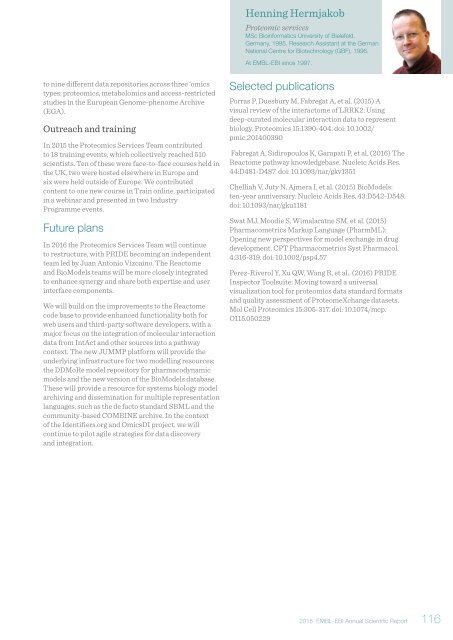Annual Scientific Report 2015
EMBL_EBI_ASR_2015_DigitalEdition
EMBL_EBI_ASR_2015_DigitalEdition
Create successful ePaper yourself
Turn your PDF publications into a flip-book with our unique Google optimized e-Paper software.
Henning Hermjakob<br />
Proteomic services<br />
MSc Bioinformatics University of Bielefeld,<br />
Germany, 1995. Research Assistant at the German<br />
National Centre for Biotechnology (GBF), 1996.<br />
At EMBL-EBI since 1997.<br />
to nine different data repositories across three ‘omics<br />
types: proteomics, metabolomics and access-restricted<br />
studies in the European Genome-phenome Archive<br />
(EGA).<br />
Outreach and training<br />
In <strong>2015</strong> the Proteomics Services Team contributed<br />
to 18 training events, which collectively reached 510<br />
scientists. Ten of these were face-to-face courses held in<br />
the UK, two were hosted elsewhere in Europe and<br />
six were held outside of Europe. We contributed<br />
content to one new course in Train online, participated<br />
in a webinar and presented in two Industry<br />
Programme events.<br />
Future plans<br />
In 2016 the Proteomics Services Team will continue<br />
to restructure, with PRIDE becoming an independent<br />
team led by Juan Antonio Vizcaino. The Reactome<br />
and BioModels teams will be more closely integrated<br />
to enhance synergy and share both expertise and user<br />
interface components.<br />
We will build on the improvements to the Reactome<br />
code base to provide enhanced functionality both for<br />
web users and third-party software developers, with a<br />
major focus on the integration of molecular interaction<br />
data from IntAct and other sources into a pathway<br />
context. The new JUMMP platform will provide the<br />
underlying infrastructure for two modelling resources:<br />
the DDMoRe model repository for pharmacodynamic<br />
models and the new version of the BioModels database.<br />
These will provide a resource for systems biology model<br />
archiving and dissemination for multiple representation<br />
languages, such as the de facto standard SBML and the<br />
community-based COMBINE archive. In the context<br />
of the Identifiers.org and OmicsDI project, we will<br />
continue to pilot agile strategies for data discovery<br />
and integration.<br />
Selected publications<br />
Porras P, Duesbury M, Fabregat A, et al. (<strong>2015</strong>) A<br />
visual review of the interactome of LRRK2: Using<br />
deep-curated molecular interaction data to represent<br />
biology. Proteomics 15:1390-404. doi: 10.1002/<br />
pmic.201400390<br />
Fabregat A, Sidiropoulos K, Garapati P, et al. (2016) The<br />
Reactome pathway knowledgebase. Nucleic Acids Res.<br />
44:D481-D487. doi: 10.1093/nar/gkv1351<br />
Chelliah V, Juty N, Ajmera I, et al. (<strong>2015</strong>) BioModels:<br />
ten-year anniversary. Nucleic Acids Res. 43:D542-D548.<br />
doi: 10.1093/nar/gku1181<br />
Swat MJ, Moodie S, Wimalaratne SM, et al. (<strong>2015</strong>)<br />
Pharmacometrics Markup Language (PharmML):<br />
Opening new perspectives for model exchange in drug<br />
development. CPT Pharmacometrics Syst Pharmacol.<br />
4:316-319. doi: 10.1002/psp4.57<br />
Perez-Riverol Y, Xu QW, Wang R, et al.. (2016) PRIDE<br />
Inspector Toolsuite: Moving toward a universal<br />
visualization tool for proteomics data standard formats<br />
and quality assessment of ProteomeXchange datasets.<br />
Mol Cell Proteomics 15:305-317. doi: 10.1074/mcp.<br />
O115.050229<br />
<strong>2015</strong> EMBL-EBI <strong>Annual</strong> <strong>Scientific</strong> <strong>Report</strong> 116


